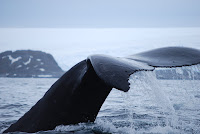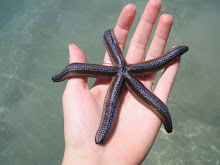 There are a few pictures up around the station that are titled "Day of the Whales, 1987" that depict zodiaks meters away from big, curious humpback whales. I never expected to experience this myself, but we marked Feb. 1st as "Day of the Whales, 2010." A day that merits this designation is more than a series of lucky close encounters or distance spout sightings. Rather, "Day of the Whales" refers to a whole day or even several hours where many pods come into the area to feed and play. Not only that, but for me it means that everything is about them rather than us, when they could care less about our presence. Well, today was certainly one of those days and it was........ for fear of using the word "surreal" yet again, I will call it phenomenal.
There are a few pictures up around the station that are titled "Day of the Whales, 1987" that depict zodiaks meters away from big, curious humpback whales. I never expected to experience this myself, but we marked Feb. 1st as "Day of the Whales, 2010." A day that merits this designation is more than a series of lucky close encounters or distance spout sightings. Rather, "Day of the Whales" refers to a whole day or even several hours where many pods come into the area to feed and play. Not only that, but for me it means that everything is about them rather than us, when they could care less about our presence. Well, today was certainly one of those days and it was........ for fear of using the word "surreal" yet again, I will call it phenomenal. Where to begin on humpback whales... Let me first set the stage. Alice and I were regrettably retained in the lab throughout the day and became more and more agitated about being cooped up inside when we could here exclamations of awe over the radios from those out on the boats following the whales around. But, we got lucky in the late afternoon and were able to sneak away when we heard that they were still there. The first few dorsal fins and tails we saw just overwhelmed me, but the bubble feeding was an entirely different and more incredible sight to witness. We could see a ring of bubbles forming on the surface..... then a fin..... then a sudden burst of activity with three or four gaping mouths surging into the air. This was always followed by a mix of strangely curved and colored body parts as the whales sank back under the surface. These were not just isolated displays but continued happening for at least an hour and in multiple pods around us and far off into the distance. Day of the Whales indeed.
 What was perhaps most incredible about this experience was how close we got to the animals. We kept a safe and respectful distance, most of the time. We were so close that we were occasionally overwhelmed by their awesome but gross-smelling spew. I felt like a whale pod groupie. They would surface, give us a frothy baleen show of bubbles, swim briefly underwater, and repeat. Each time they moved, we moved alongside or behind and then oooooed and aaahed when they came up again.
What was perhaps most incredible about this experience was how close we got to the animals. We kept a safe and respectful distance, most of the time. We were so close that we were occasionally overwhelmed by their awesome but gross-smelling spew. I felt like a whale pod groupie. They would surface, give us a frothy baleen show of bubbles, swim briefly underwater, and repeat. Each time they moved, we moved alongside or behind and then oooooed and aaahed when they came up again. We followed one pod along the backside of the penguin island as they moved away. At one point, they seemed to take a turn in front of us and suddenly, the unbelievable happened! One and then another of the whales breached and flew into the air. The second even added a half twist for effect. We were all nearly speechless! It was like a postcard or some other picture-perfect representation of reality. The penguins and birds were also taking advantage of the krill that the whales were driving to the surface. It was a beautiful display of natural excitement. Overall I think the most awe-inspiring aspects of them are their size and grace. Their backs are massive coming out of the water; pinnochio really could have been easily swallowed in the surge of water entering their bodies.
As you can imagine, this was an incredible ending to our final, more normal day here at the station. Tomorrow the boat arrives and the whole place will be abuzz with cargo operations, changing room assignments, and a great amount of science equipment being disassembled and reassembled or packed away. It is difficult to imagine what it will be like having our big ship docked at the pier and seeing distantly familiar faces that signify leaving. Last night, the Gould did a fly-by and appeared out of nowhere off at the very limits of our boating range. It went something like this: "IS THAT THE GOULD?!?!?! Nooooooo!" It just feels like an intrusion to even think about disrupting the routines we have established here.
But, in truth, I am ready to come home and have so much to look forward to when I do. I am only trying to convey how strongly confused and emotional this transition feels. But, I am guessing that once the ship arrives, it will all feel natural to carry my suitcase down the plank and back into the bowels of the ship. It has just been such a grand adventure, and because it has been so big, I almost don't feel too sentimental about it. There haven't been any "lasts" to worry about because I have already absorbed more than I ever thought possible. Thank you, whales, for the great show. They must have known it was a special night!







Hi Amanda, this being the only post where you mention algae, here's where I'll ask my question. I'm wondering if you've heard anything about "algae blooms". Evidently, these plants are at the center of one of the worst-case-scenario, hack-the-earth solutions to global warming. Algae blooms grow well in nutrient-rich Antarctic waters. Humans would only need to add a dilute solution of iron to the stew to make them grow. Since these plants are a known "carbon sink", some scientists are talking about possibly growing large farms down there. But it's a worst case scenario solution because no one knows what, if any, effects would come from doing this. When humans introduced killer bees to Latin America, it seemed like a good idea at the time. Now that they have taken over the other bee populations, it doesn't looks so good...
ReplyDelete